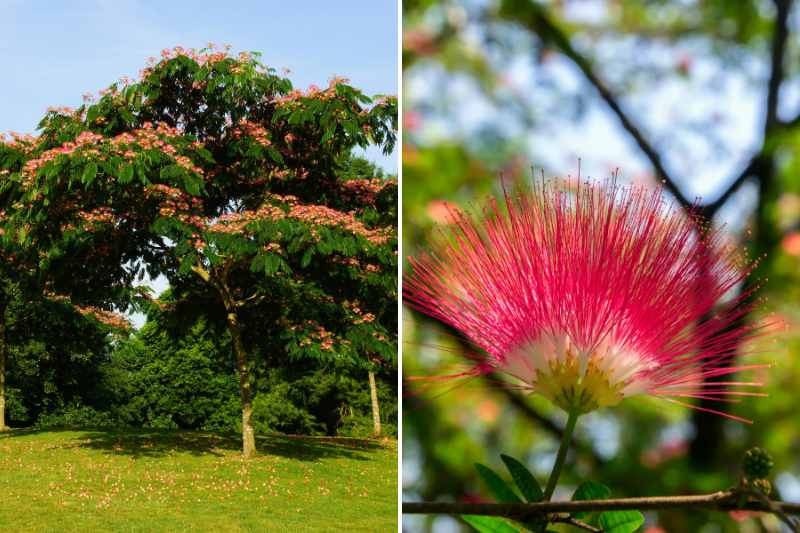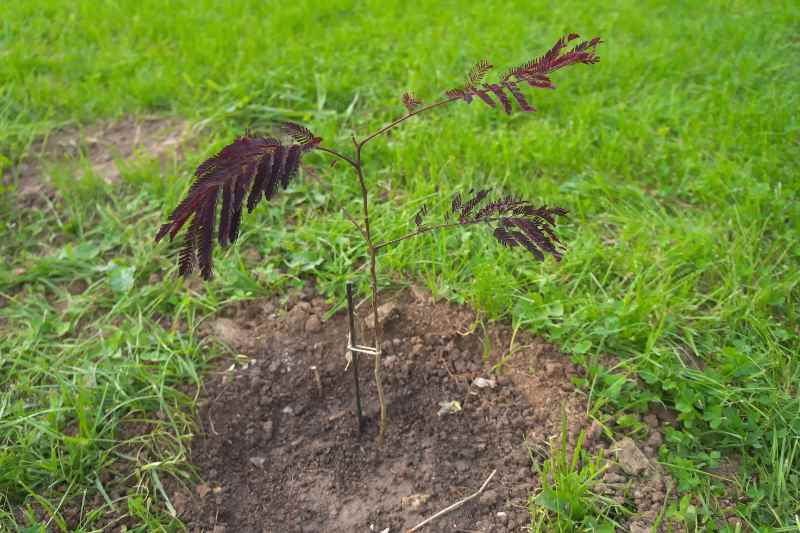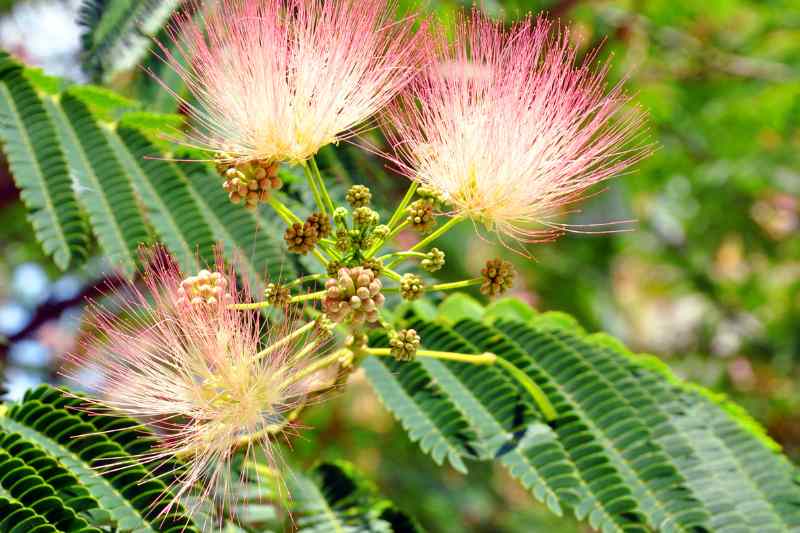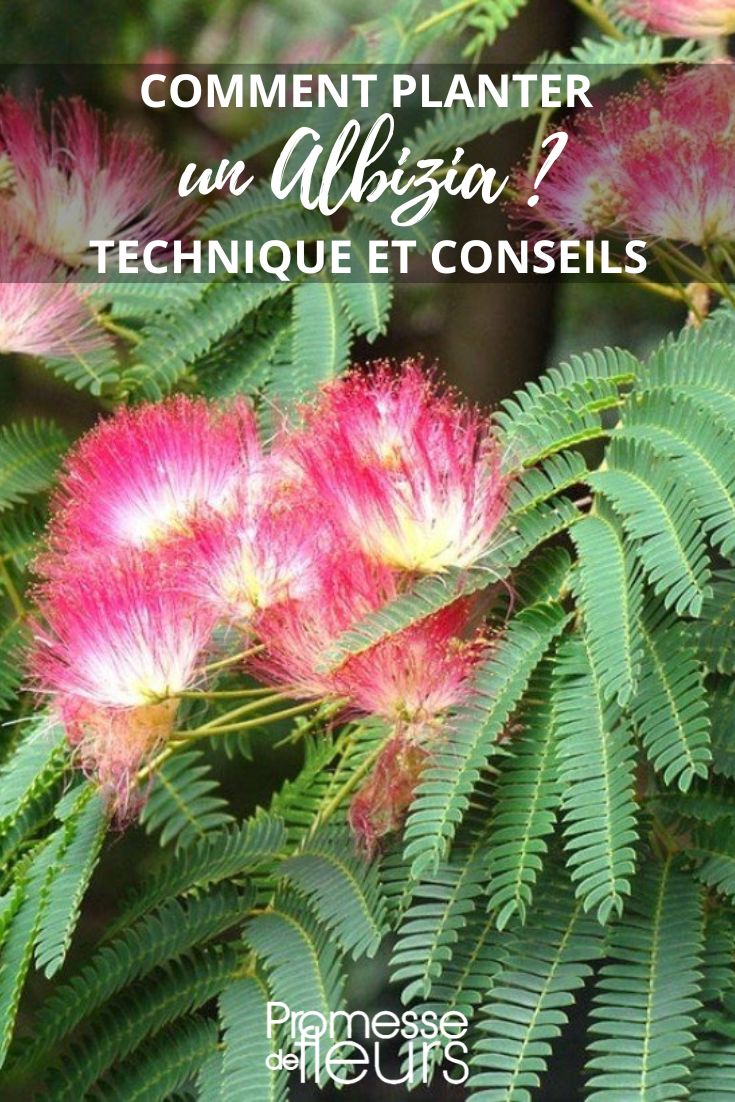Dreaming of an exotic, colourful garden? Albizia, also known as the silk tree or Constantinople acacia, is a perfect choice! With its airy foliage and silky pink pompom flowers, this tree brings a touch of poetry and freshness to any outdoor space. In this complete guide, discover how to successfully plant this majestic tree and the care needed for it to thrive.
Albizia: an ornamental tree full of charm
Native to Asia, Albizia (Albizia julibrissin) is a decorative tree valued for its spectacular summer flowering and elegant umbrella habit. It is called "silk tree" because of its delicate, silky flowers. It is a hardy tree, able to withstand temperatures down to −10 °C depending on variety, while appreciating warm, sunny climates.
Thanks to its rapid growth and light deciduous foliage, it creates pleasant shade, perfect for gardens.
For everything about growing this tree, read Albizia: plant, prune and maintain.

When to plant an Albizia?
The best time to plant an Albizia is autumn, ideally between October and November, while soil is still warm. This allows roots to establish well before severe cold arrives.
If you live in an area with harsh winters, prefer planting in spring, as soon as risk of frost has passed (April–May). Albizia needs warmth to develop properly, so avoid planting in winter.
Required equipment
- Spade for digging planting hole — spades, shovels and forks.
- Rich, well-draining compost.
- Sturdy stakes and gardening guying straps.
- Watering can
How to plant an Albizia?
Choose the right location
Albizia loves warm, bright conditions. Here are some tips to find the best spot in your garden:
- Aspect : place Albizia in an area receiving at least six hours of direct sun per day. The sunnier the spot, the more spectacular the flowering.
- Wind protection : although Albizia is relatively robust, its branches and light foliage can be damaged by strong winds. Plant it near a wall or hedge that will protect it without completely blocking light.
- Spacing : leave at least 4–6 metres around the tree. Once mature, Albizia adopts an umbrella habit, with branches spreading widely. It would be a pity if it lacked space to grow harmoniously.
Prepare the soil
Well-prepared soil is key to successful planting. Albizia is undemanding but prefers certain conditions:
- Drainage : this tree does not like its feet in water. If soil is heavy or clayey, mix in compost or fine gravel to improve drainage. This will prevent water from stagnating around the roots, which could asphyxiate them.
- Fertility : add some well-rotted compost to provide nutrients for a good start. If soil is naturally fertile, this addition can be facultative.
- Loosening : before planting, turn soil to about 50 cm depth to aerate it. This will allow young roots to develop more easily.
Dig the planting hole
Preparing the hole is an important step to ensure good establishment:
- Ideal dimensions : hole should be about 60 cm deep and wide, at least twice the size of the root ball or root system.
- Why so big? : this gives roots loose soil to spread into and ensures the tree can anchor well in its environment.
- Prepare the base : if soil is particularly compact or stony, loosen the base of the hole with a fork to facilitate root penetration.
Place the tree
- Positioning : place the root ball in the centre of the hole. Ensure the collar (the junction between trunk and roots) is at ground level. If the collar is buried, the tree may rot; if too high, roots could dry out.
- Adjustment : before backfilling, check the tree is straight. Take time to adjust now, as once the hole is backfilled it will be harder to correct.
Stake the tree
Staking is important, especially for a young Albizia that could be weakened by wind or its own weight:
- Choice of stakes : to stabilise a young Albizia, use three stakes arranged in a triangle around the trunk (tripod staking), fixed with soft ties to distribute forces and avoid wind damage. Maintain this guying for 1–2 years, checking ties regularly, until the tree is well rooted and self-supporting.
- Positioning : drive stakes in at an angle, about 50–70 cm from the trunk, pointing outwards so as not to damage roots.
- Fixing : use soft, durable ties such as guying straps or rope to avoid injuring bark. Attach trunk to each stake with slight tension and form a figure-eight knot. This allows slight trunk movement while remaining supported, strengthening natural sturdiness.

Backfill and water
This final stage stabilises the tree and puts it in the best conditions to get off to a good start:
- Backfilling : backfill gradually with a mix of excavated soil and, if needed, compost. Firm gently with hands or feet to avoid air pockets.
- Create a basin : once the hole is filled, form a slight basin around the base of the tree. This basin will hold watering and ensure it soaks directly to the roots.
- Watering : water generously with 10–15 litres of water immediately after planting. This helps settle soil naturally and hydrate roots. Subsequent waterings should be regular, especially during first weeks, but avoid excess to prevent rot.
Care after planting
Once Albizia is in the ground, a few simple actions are enough to see it grow in good health.
Watering
During the first year, water regularly, especially in dry periods, to encourage rooting. Once established, Albizia is drought tolerant.
Mulching
Apply a layer of mulch at the base of the tree to conserve moisture and limit weed growth. This is particularly useful in summer.
Frost protection
In cold regions, protect the base of the tree with a thick mulch or a frost protection fleece during first winters.
Pruning
Albizia does not require strict pruning, but you can remove dead or poorly placed branches at the end of winter. This will encourage harmonious growth.

































Comments